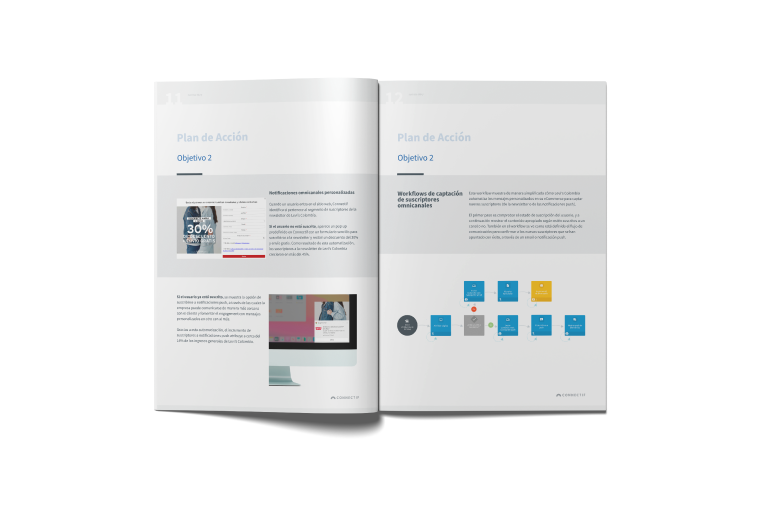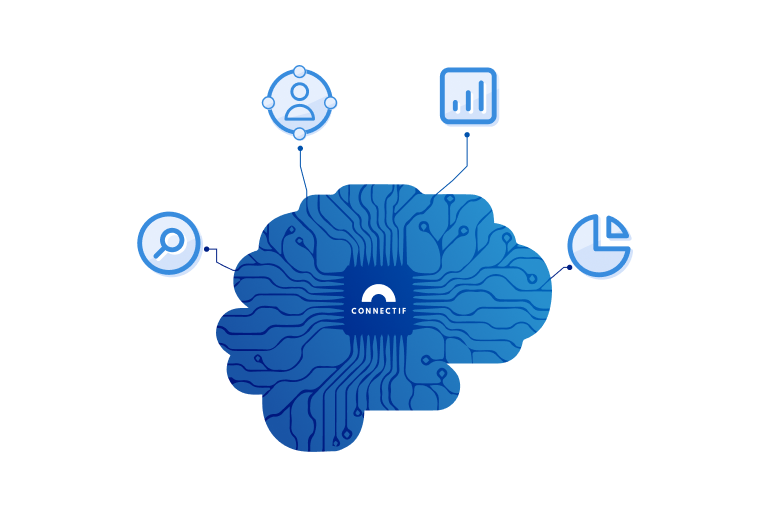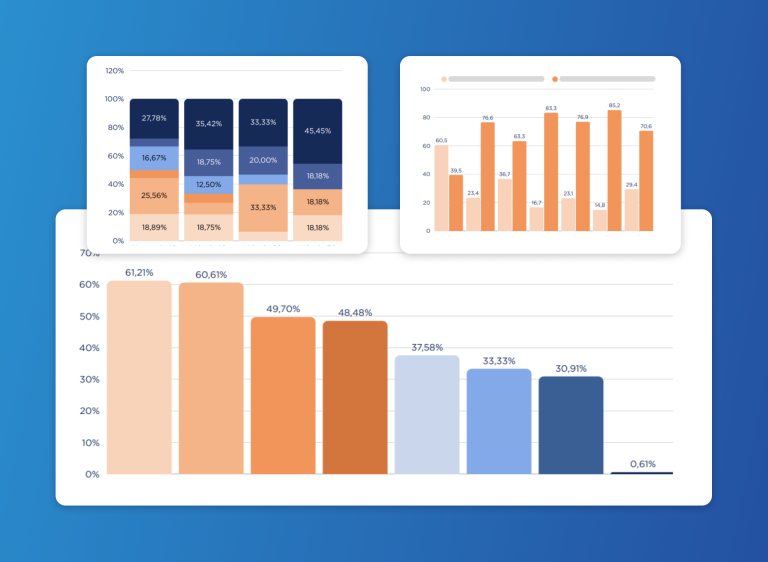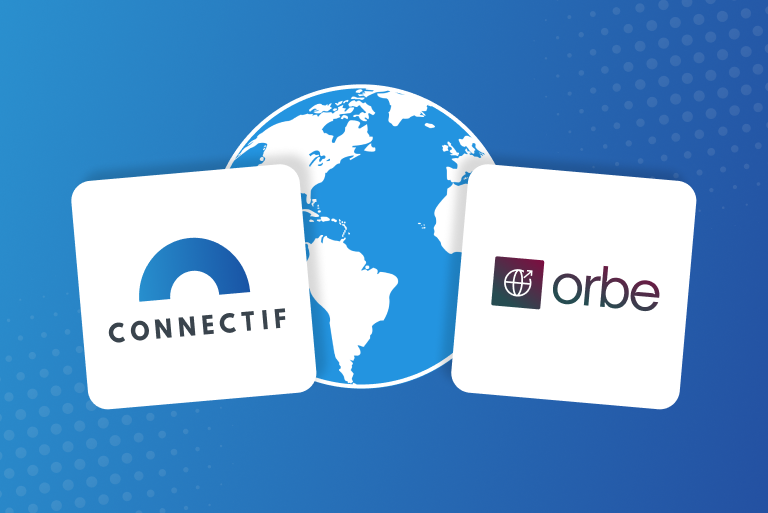Over the past decade, we’ve witnessed an unprecedented evolution in the field of artificial intelligence, with exponential growth in its capacity and applications, and a steady increase in platforms and companies embracing the phrase “AI-driven.” This phenomenon is supported by data showing a notable rise in the use of AI in the realm of marketing, where its application spans from content creation to SEO optimization, marketing automation, virtual assistants, and other typical uses today.
For eCommerce marketers, AI represents an unparalleled opportunity to deploy more effective strategies. It enables more impactful communication, quicker and more efficient sales generation, deeper analysis, and smarter decision-making in less time.
With this article, we aim to cut through the noise surrounding AI and present concrete examples of the true “power” this technology holds in implementing omnichannel marketing strategies. We’ll focus on how artificial intelligence can enhance engagement, increase conversion, and foster customer loyalty, with real cases and examples from major eCommerce brands leveraging AI to amplify the impact of their strategies.
We’ll explore how artificial intelligence serves marketers in achieving effective omnichannel communication, precise audience segmentation, individualized customer experience personalization, deeper analysis of available data, and optimization of various aspects of online purchasing, among other benefits.
#1 – Real-Time tracking: observe and act
The first step towards true revolution in the eCommerce world is data collection, including information derived from online stores (visits, purchases, preferences, carts), physical stores, personalized events, and various channels (email, push notifications, pop-ups, SMS, WhatsApp), providing marketers with a valuable source of knowledge.
But the real magic lies in the ability to access data generated by eCommerce customers in real-time (First-Party Data), as they provide a competitive advantage by allowing companies to make more informed and timely decisions, quickly adapt to market changes, and offer more personalized and relevant experiences to customers.
Our artificial intelligence-driven platform not only tracks users’ digital footprint but also provides marketers with a holistic view of what’s happening on their eCommerce site. This is key to addressing each user individually, incentivizing each desired action, and turning every visit into an unforgettable experience.
By using first-party data, AI can predict valuable information about your customers to create unique, relevant, and personalized experiences across multiple devices. In addition to helping you make intelligent product recommendations, you can also leverage artificial intelligence to deliver better search results and gain deeper insights into your users, including their sentiments, needs, interests, and behavior.
This data collection practice is crucial for several reasons:
- Precision and relevance: First-Party Data provides direct information about our customers’ actions, enabling relevant predictions about future actions they might take. AI algorithms rely on high-quality data to make precise predictions and recommendations, and by utilizing First-Party Data, AI can better understand customers’ preferences, behaviors, and needs, allowing for more precise targeting and personalization.
- Personalization and insight: First-Party Data allows companies to gain deeper insights into their customers’ behaviors, preferences, and purchasing patterns. Artificial intelligence can analyze this data to uncover valuable insights and trends that can transform marketers’ strategies, product development, and customer experiences. This level of personalization and understanding is not achievable with third-party data alone.
- Building long-term relationships: by collecting first-party data directly from customers, companies can build stronger and more personalized relationships over time. AI can help analyze this data to identify retention opportunities, loyalty programs, and personalized communication strategies, ultimately leading to higher customer retention and increased CLV.
Real-time tracking of digital footprint traffic is not just an analytical tool but also allows us to see beyond clicks and conversions, truly understanding who they are, what they need, and how we can help them achieve their dreams.
#2 – Omnichannel prowess: the unified experience you need
Once AI has all the data, you’ll be ready to take your marketing strategies to the next level, especially when transitioning from multichannel to omnichannel marketing. Did you know that by offering an omnichannel experience on your eCommerce platform, you can increase customer engagement by up to 270%?
But if you still don’t know the difference between multichannel and omnichannel marketing, keep reading to understand it.
In multichannel marketing, companies interact with customers through various channels such as email, social media, websites, and physical stores, but each channel operates independently with its own strategies, goals, and data. The aim is to have a presence on multiple platforms to reach a broader audience, although coordination between channels may be limited, leading to inconsistencies in messaging and customer experience.
In contrast, omnichannel marketing adopts a holistic approach, aiming to provide a seamless and integrated experience to customers across all channels. It emphasizes consistency and continuity in messaging, branding, and customer experience, regardless of the channel or device used. Data and information from each channel are integrated and used to create a unified view of the customer journey, with a focus on delivering personalized and contextually relevant experiences to anticipate customer needs and facilitate smooth transitions between channels. Omnichannel marketing recognizes that customers can fluidly move between online and offline channels and seeks to provide a consistent experience across all touchpoints.
Artificial intelligence powers omnichannel marketing in several ways:
- Data integration and analysis: firstly, AI algorithms can analyze large amounts of data from various channels and sources to create a unified view of each customer, enabling personalized and specific interactions across all channels.
- Personalization: additionally, AI allows for personalized content, product recommendations, and offers to customers based on their past interactions, preferences, and browsing history. By leveraging AI-driven personalization, companies can enhance engagement, increase conversion rates, and build stronger customer relationships across all channels.
- Predictive analysis: finally, AI-driven predictive analysis can predict customer behavior and preferences, enabling companies to anticipate their needs and provide proactive assistance or offers, thereby improving the overall customer experience and fostering loyalty through relevant and timely communication on the preferred channel.
A case in point is Levi’s, one of the world’s largest fashion brands: following the migration to Connectif, Levi’s Colombia was able to identify and segment both their known and anonymous users, and then launch specific and relevant omnichannel communications to each customer (from newsletter emails to push notifications). By intelligently utilizing various channels, they increased their sales by 14%.

As you can see, while multichannel marketing focuses on capturing customers through various channels, omnichannel marketing goes a step further by offering an integrated and coherent experience where the customer is the true protagonist.
#3 – Smart segmentation: the art of precision
Segmentation ranks among the top ten challenges faced by marketers. Interestingly, those who use segmented campaigns report an impressive increase in revenue, reaching up to a 760% revenue boost. Undoubtedly, this highlights the transformative power of smart segmentation as the key driver of a successful marketing strategy.
While many tools allow marketers to divide customers into smaller segments based on common characteristics or behaviors, such as demographics or geography, nowadays that’s not enough. Thanks to AI, audience segmentation goes far beyond these traditional variables.
Our clients are experiencing more advanced segmentation strategies, paving the way for even more precise targeting. For example, marketers can automatically create multiple audience segments based on predictive metrics like CLV, to determine who are the customers likely to spend more on your eCommerce, how many purchases they will make, or who are these first-time customers who may potentially become the highest value contributors in the future. AI algorithms analyze extensive datasets to identify patterns and behaviors, facilitating the creation of highly precise and refined customer segments. This ensures that marketing efforts are directed towards the right audience, maximizing the relevance and impact of each action, and thereby, sales and retention.
Kave Home, a leading brand in the design, manufacturing, and distribution of furniture, used the RFM metric to identify inactive customers who have not made a purchase on their eCommerce for a while, segment them, and effectively target them with a strategy to reactivate them. The result? They reactivated 20% of dormant customers thanks to smart segmentation based on the recency metric.

Furthermore, AI simplifies targeting key audiences on social media by using advanced algorithms that analyze user behavior and preferences on these platforms. These algorithms can more accurately identify audience segments that are most likely to positively respond to marketing messages, enabling companies to target their advertising campaigns more effectively and achieve better results.
On the other hand, regarding the implementation of dynamic landing pages in an eCommerce setting, AI streamlines the process by automating the generation of personalized versions of these pages based on data collected about user behavior and preferences. This means that companies can quickly create pages tailored to different audience segments or even individual users, thus maximizing the relevance and effectiveness of their marketing messages.
By providing a contextualized customer journey tailored to their specific needs, Return on Advertising Spend (ROAS) can be increased to extraordinary levels.
A notable example is the case of Hemper, a regenerative fashion brand focused on developing products with natural fibers and dyes, which after identifying customers who often purchased during discount campaigns, created a specific segment called “Discount Lovers” to impact them on Meta each time a discount campaign was launched. The result? They increased ROAS by an impressive 154%.
#4 – Experience personalization: the personal touches that make all the difference
Experience personalization is key in the world of marketing, with 79% of customers showing a greater inclination towards brands that offer personalized attention. With the help of artificial intelligence, marketing professionals have the ability to meticulously analyze the behavior of each customer, identifying individual patterns and preferences. This treasure trove of information allows for extreme customization of content, tailored messages, and recommendations so precise that your customers might feel like you’ve known them for a lifetime. Moreover, with AI, it’s possible to tailor a website for each customer, making each one experience a unique eCommerce tailored specifically to their needs and preferences.

But AI doesn’t stop at just analyzing user behavior and past preferences; it also offers clues about what customers might desire next. This way, not only are current needs met, but future ones are also anticipated.
A notable example is ESPRIT, a recognized international fashion brand, which chose to offer personalized product recommendations through the implementation of dynamic showcases at key points on its website. These showcases, driven by algorithms, were based on the digital footprint and First-Party data of its customers. They developed a series of recommendation strategies that allowed them to personalize both the homepage and each product page based on insights from the behavior they gather from their users, achieving an impressive 19% increase in average order value.
With tools like Connectif, it’s possible to personalize every stage of the customer journey, surprising all users with tailored marketing campaigns, hyper-personalized content, and relevant recommendations. This personalization is based on an unlimited memory of customer behaviors, demonstrating a true understanding of their needs and desires. By showing genuine care for customers and offering them exceptional experiences, companies can cultivate customer loyalty and ensure their return for future interactions.
#5 – Analysis: uncover the power of your data
AI-driven analytics represent an invaluable tool for marketing professionals, providing them with unprecedented insights into their customers’ behavior. By deciphering intricate patterns and trends, marketers can anticipate the needs and preferences of their customers, elevating their marketing campaigns to a higher level across every channel. This proactive approach not only enhances the customer experience but also strengthens loyalty and satisfaction.
Imagine being able to analyze hundreds of metrics and foresee the future in the blink of an eye: from predicting abandonment rates on your eCommerce platform to understanding the likelihood of repeat purchases or the potential total spend of certain customers. With these advanced analytical capabilities, companies can truly understand what is happening and what is to come in their online store, gaining a holistic view of their business in seconds.
This approach allows marketers to delve deeper into their data to analyze, compare, learn, predict, and create even more engaging customer journeys, turning them into true marketing superheroes.
A successful example is the case of Gioseppo, which increased CLV by 8% by identifying and targeting its most loyal and high-value customers, as well as Pienso y Mascotas, which reactivated 30% of customers at risk of churn. These examples underscore the importance of predictive analysis in anticipating customer behavior in the e-commerce environment. By truly understanding all the needs and behaviors of customers, companies can adapt their marketing strategies more effectively, offering relevant and personalized messages that increase customer engagement and satisfaction.

The Data Explorer from Connectif opens up a world of possibilities, enabling companies to extract deeper insights and uncover unique perspectives that may not be as evident through conventional methods. By delving into these insights, marketers can develop innovative strategies that differentiate them from the competition and create more meaningful connections with their customers.
Embracing a “Data First” approach and exploring new perspectives and viewpoints allows companies to unlock powerful opportunities to drive growth and enhance customer engagement.
And this is just the beginning…
With the ongoing development of artificial intelligence and technologies like machine learning (ML) and natural language processing (NLP), marketers can expect the emergence of new ways in which AI can help them gain an even better understanding of their customers, comprehend and predict their intentions, and respond accordingly to become marketing superheroes.
In addition to the mentioned trends, there are other future forecasts that will shape the landscape of digital marketing:
- New artificial intelligences, based on neural networks, are learning to generate texts and books on their own.
- AI-based applications, like DALL-E, will continue to develop to instantly offer quality videos and images.
- Autonomous agents will continue to be developed, using data to learn, adapt to new situations, and make decisions with minimal human intervention.
- Augmented reality (AR) and virtual reality (VR) will also benefit from AI advancements, with applications in experiential marketing and product visualization offering immersive experiences to customers.
- Further advancements in conversational AI are expected, with increasingly sophisticated chatbot systems and virtual assistants capable of holding natural conversations and effectively addressing customer inquiries.
With the increasing impact of AI in the world, its contribution to the market is expected to be significant. According to projections, the natural language processing (NLP) segment of the AI market will surpass $112 billion by 2030. Additionally, 97% of users already use voice search or other forms of AI-driven voice assistance. On the other hand, the conversational AI market is projected to reach $43.7 billion by 2030, growing at a compound annual growth rate of 23.9% from 2023 to 2030.
Marketers will have increasingly more opportunities to enhance their businesses through artificial intelligence. The use of AI applied to eCommerce is already making life easier for marketers worldwide, and its application in everyday life varies across different areas.
Some examples include SellarAI, which optimizes product listings to improve search rankings and increase visibility on marketplaces, Sniffie, a tool designed for eCommerce companies to optimize pricing strategies, improve competitiveness, and maximize profits, or Pixelcut, an AI platform that any brand can use to bid farewell to boring stock photos and give product photos captivating visual appeal.
These data underscore the increasingly significant impact of AI in the eCommerce sector and the importance of its adoption for marketers who strive every day to deliver unforgettable shopping experiences.
In a world driven by innovation and creativity, artificial intelligence becomes the indispensable ally of those seeking to stand out and become true marketing superheroes.
Conclusion
In this exciting journey towards the future of eCommerce, AI not only guides us but also inspires us to reach new heights of excellence and reinvent the way we interact with our customers. Advances in this technology have equipped us with powerful tools to create unparalleled experiences, thus raising the standard of excellence in the industry.
Some common uses of AI in this sector include using data to control pricing strategy, implementing smart product recommendations, and offering more personalized experiences to customers. At the same time, AI is also a useful tool for fraud prevention, inventory management, and automating repetitive tasks.
However, let us remember that the power of artificial intelligence lies not only in its complexity but in our understanding and mastery of it. Before incorporating this revolutionary technology into an eCommerce strategy, it is imperative that we arm ourselves with the necessary knowledge to fully harness its potential. Successful implementation of AI is not just about automating tasks but about forging clear strategies and effective processes that drive business growth.
At Connectif, we have been working with AI even before the discovery of ChatGPT… and we are committed as leaders in new technologies to ensure that marketers using Connectif have all the necessary power to transform the results of their strategies and take eCommerce to the next level.
So, if you are a marketer willing to challenge the limits and explore new horizons, differentiate yourself from the rest: Connectif is the platform for you.




